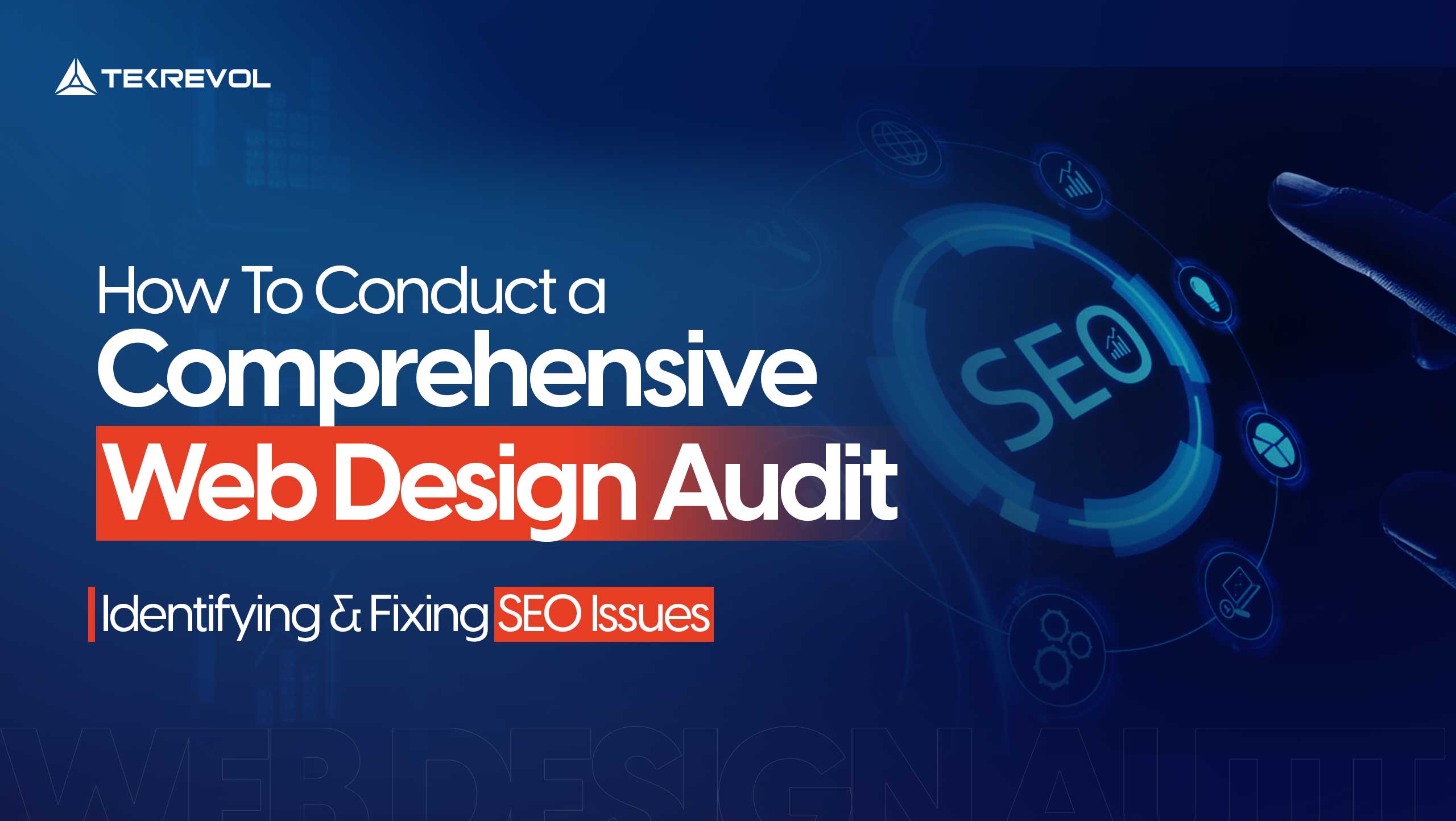A website design audit is a thorough evaluation of a website’s visual, structural, and general operation about user expectations and business objectives.
A website might not achieve its desired rankings due to various errors in design and SEO that hinder its overall success. These problems may affect your rankings or visibility in search engines or other features of your site, which can reduce its performance.
The solution? A website design audit or a website SEO audit will assist you in identifying such problems, attracting more organic traffic, and improving the efficacy of your website.
Auditing should be done frequently to improve the effectiveness of your website. If you are unsure how to do these audits and need a solution that will provide great effects for the site, it is best to seek professional search engine optimization services.
Whether you are considering revamping your website or are new to audits, this blog will walk you through the process step by step.
- Is Your Website Optimized for Growth?
- Identify unseen design flaws that are affecting your lead generation and conversion rates.
What is a Website Design Audit?
A web design audit is a thorough study of your website to determine its effectiveness, aesthetically pleasing design, functionality, and alignment with your company’s present and future goals. This can be compared to an online brand health check. The Website Audit finds problems and sets targets to improve health, much like a medical examination.
Importance of Regular Web Design Audits
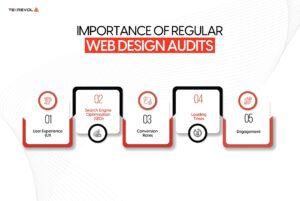
Web design auditing is a crucial necessity in every business that wishes to survive in a contemporary competitive world. Here’s why:
User Experience (UX): Any web design must be aimed at creating a user-friendly interface for a website. An audit helps you analyze the users’ behavior, find problematic spots, and introduce improvements that would make navigation smooth and easy. Implementing UX brings customer satisfaction and in turn, customer retention.
Search Engine Optimization (SEO): Any website that has little or no SEO is probably losing out on a lot of potential organic traffic. If you’re wondering how to fix SEO issues, when auditing, you should consider your keyword choice, title and meta descriptions, and backlink profiles, to check if your website ranks higher for relevant keywords.
Conversion Rates: A primary goal of any website is to generate leads, which are often converted into customers. Conversions can be hampered by a poorly designed navigation path, and a website audit may reveal problems with accessibility and CTA placement. If tackled, these aspects will help you have a better chance of converting your website visitors into buyers.
Loading Times: The speed of a website’s pages has a big impact on user experience and sales. Studies reveal that page loading time negatively impacts bounce rates and thus company revenues. Web design audit enables the evaluation of performance and making necessary changes, thus helping in determining the best page load speeds.
Engagement: It is crucial to ensure that the target audience stays engaged as this helps in directing them through the different stages in the funnel. An audit can assist in the discovery of engaging features like animations or videos, that may make the visitors spend more time on your website.
- Do you want to elevate your website’s user experience?
- TekRevol offers customized UX/UI design services tailored to your specific needs.
Types of Website Design Audits
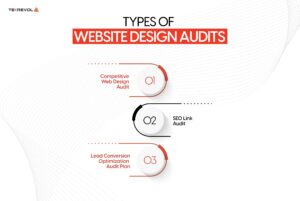
As the competition between businesses in the online market increases, every website needs proper optimization to survive. However, sometimes the most appealing sites can actually have problems that prevent them from working correctly.
A number of audits may be useful in finding out such drawbacks and giving recommendations on the further performance of the site. Following is a detailed analysis of the different website design audits to increase your site’s effectiveness.
Competitive Web Design Audit
It’s important to gauge your website’s effectiveness in comparison to your market rivals. A competitive web design audit is a great chance to peek at the strategies of your contenders and learn from them.
According to a reputable web design company in New Jersey, they always start the audit by conducting a competitor study, with a focus on the competitor’s website’s strengths, flaws, opportunities, and threats. This can help you find areas for improvement on your own website while also highlighting development prospects and risks.
SEO Link Audit
Now it is high time to decide about the quality of the website link profile. Do your backinks help to improve your visibility or are they acting in the opposite way? By utilizing a backlink checker such as that offered by Ahrefs, one can quickly gauge their link strategy. It allows you to tell which of the links you get are helpful and which may be damaging to your site and helps you find out the best way to improve website SEO.
Lead Conversion Optimization Audit Plan
Getting visits to your website is a wonderful start, but converting them into leads is where the hard work starts. If your website is seeing plenty of visits but conversions are low, it’s a clear sign you need to work on your lead conversion rate.
Use Google Analytics to track traffic patterns and understand user engagement. Is your content still fresh and engaging, or is it time for an update? By increasing your effort, you can transform your site into a strong converted one, which is the primary source of conversion.
Benefits of Website Design Audits

1. Enhance Your Search Engine Performance
Website design audit is not just about the look and feel of the site, instead, it is vital when it comes to enhancing the site’s rank on the internet. Can you imagine your website appearing at the top of the list of search results every time? By doing so, there will be more clicks, traffic, and finally, more profits which will help the owners of the websites greatly.
2. Boost Usability
With advances in usability and accessibility standards, a design audit can help you ensure that your site is still welcoming to all visitors. It may necessitate revisiting the subject’s subtopics and analyzing how they are structured, or ensuring that each page is properly optimized.
In this manner, more of the visits to your website will result in sales than if the user had to search through numerous parts.
3. Strengthen Branding
Website design trends change over time, and so should yours. A design audit assists you in this awareness so that your website continues to represent your brand accurately. This makes your site presentable to the users and it is always up to date hence giving you a competitive advantage.
Key Elements of a Website Design Audit
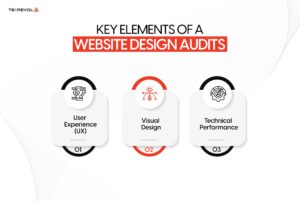
A comprehensive website design audit is crucial to enhancing the online presence of an organization. Here are the core elements you should consider:
1. User Experience (UX)
User experience is the main point of any website that tries to provide good services. Rather, it is focused on how people interact with your website, including their user experience and enjoyment of it. Poor design selections can create situations that drive away potential purchasers, resulting in a loss of sales. Key factors to evaluate include:
Navigation: Is it simple to navigate your website? A well-designed website should guarantee that a user may get the desired page in two or fewer clicks. Users are more satisfied when navigating a system that is well-structured and does not cause frustration.
Mobile Responsiveness: With the increasing use of mobile devices, your website must appear great on both larger and smaller screens. Another advantage is that the site’s design will be optimized for mobile devices.
Page Speed: Longer pages take longer to load, which can cause many users to leave the website, resulting in high bounce rates. For example, Google established a website called PageSpeed Insights to help customers understand how well their site is performing and where they may need to make adjustments to improve the user experience.
Content Clarity: Is your material interesting and relevant? A well-structured material allows consumers to quickly find what they’re looking for. The use of clear and detailed headings, bullet points, and streamlined phrasing improves overall usability and user satisfaction.
Calls to Action: Check the placement and design of calls to action (CTAs) to ensure they are both clear and compelling. When properly designed, CTAs must assist users in converting, whether it is to sign up for a newsletter or to purchase a product.
Accessibility: It is critical to make your site accessible to the impaired, thus adhering to the WCAG rules. Making a site as accessible as possible means increasing its audience, and making it more useful for everyone.
2. Visual Design
Brand identity is a very important concept when it comes to visual design as it forms the perception that users have about a certain brand. Creating an appealing aesthetic that reflects your brand and appeals to your target audience is part of it. When evaluating visual design, consider the following:
Consistency: Using the same font style and colors together with the layouts used in a website’s face page increases its utility. The layout of the web pages visually integrates your website so that it looks professional and credible.
Imagery: Verify that your photos convey the image you want for your brand. Visuals have the power to either enhance the user experience or hinder the successful delivery of your brand’s message.
Typography: It is advisable to use clear fonts and increase the spacing between lines to improve readability to the point where people can read more easily.
Color Scheme: A color scheme that is pleasant to the eye might improve usability. A clear contrast between the backdrop color and the text will make it easier for users to read and engage with your information.
3. Technical Performance
The most colorful and pleasing website is not very useful if its application is not effective for use. A design audit should include a thorough evaluation of technical aspects, such as:
Site speed optimization: Long loading times diminish website traffic conversion rates since many people are likely to leave the site. Make sure the image is indeed that size, use a CDN, and keep JavaScript to a minimum to ensure quick loading times and user attention.
Security: Verify that your website is SSL-certified and that additional security measures are in place. Users benefit from a safe website, which also protects crucial data confidentiality.
Cross-browser Compatibility: Check cross-browser compatibility to see how your website operates in other browsers. User compatibility has the power to create or break the system’s usefulness and possible business opportunities.
SEO Optimization: Evaluate the website’s internal and external factors, such as the content description, title, and header. When executed appropriately, SEO best practices improve your search engine rating and visibility, as well as the number of visits from users who enter the URL into the search engines.
- Fix Design Issues Before They Impact ROI
- Identify and resolve UX/UI challenges that could be hurting your bottom line.
Key Indicators Your Website Needs a Design Refresh
Wondering if it’s time for you to have your website checked for a design audit? Here are some clear indicators:
1. Declining User Engagement
Are page views and visitors reducing and bounce rates going up at your site? If the user is not active on the website/app, there is a high chance something is not right. An audit of a website’s design can help identify areas for improvement, make the site less boring, increase its stickiness, and eventually increase conversion.
2. User Experience (UX) Issues
Users who are unable to discriminate between poor and favorable ratings will not stay on your platform. If a visitor needs help figuring out where to go or what to do on your website, they probably need assistance revamping it. The design audit focuses on areas that need to be made more user-friendly, allowing the process to flow more smoothly.
3. Outdated Visuals or Branding
Is your website so out of date that it appears to be from another time? Old logos might be detrimental because they do not promote a positive image. A design refresh improves the appearance of your website, ensuring that it is consistent with modern design principles and your brand image.
4. Inconsistent Design Elements
Is there any confusion or indicators that conflict on your site? Lack of integration may lead to user uncertainty and lower your brand’s perceived influence. Website design auditing reduces the number of mixed-up or unclear messages that users receive by improving the look and feel to appear more professional.
5. Poor Website Performance
Do you have slow pages or low conversion rates? Poor performance is capable of deterring users. A design audit exposes faults that impede performance, providing an opportunity for designers to improve speed, functionality, and conversion.
How to Conduct an Effective Website Design Audit? 6 Key Steps
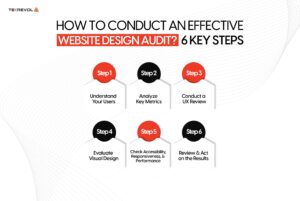
Website design audit is important to understand that your website not only is beautiful to look at but also effective in reaching the goals for the users and the business. If you’re ready to give your website a detailed checkup, here are six key steps to guide you through the process:
Step 1: Understand Your Users
Before designing a successful strategy, it is critical to understand who and what your users are. Collect data utilizing apps like Google Analytics and Hotjar to better understand their behavior, interests, and needs. Creating user personas will help you focus your website improvement efforts and determine their relevance to your users.
Step 2: Analyze Key Metrics
Check your website’s bounce rate, average time spent on the site, and conversion rate, among other metrics, using Google Analytics and SEMRush. It enables you to find areas that require additional attention or whether your website may be more efficient in terms of performance.
Step 3: Conduct a UX Review
Several factors contribute to the success of your website, but the most important one is User Experience or UX. An aesthetically appealing website layout and a visually appealing website lead to users’ prolonged time on the website while exploring the website thus resulting in a good conversion rate. Start by conducting a thorough UX review using usability testing tools like:
Hotjar: Offers heatmaps and session replays that demonstrate where users are clicking, scrolling, or exiting your site. This assists in making you know some areas that require amendment.
UsabilityHub: Provides tools to learn more about users’ behavior on your website, especially navigation, layout, and CTAs.
Crazy Egg: One of the best tools for heatmaps and scroll maps, which will assist you in understanding how far the users go down the page and at what distance they get bored.
Answer important questions with these tools, such as: Is it easy for users to navigate your site? Are CTAs convincing and easy to see? Are forms useful?
Step 4: Evaluate Visual Design
Do a visual audit of your website’s designs and appearances. Is the design new, clean, and managed on all the site’s pages? Is it representative of your brand correctly? These are minor factors that have the potential to either make or break your business among the users. For real feedback, one can use tools such as Hotjar or even a basic survey to find out what users have to say.
Step 5: Check Accessibility, Responsiveness, & Performance
Always ensure that your website works smoothly on all devices, including desktops, laptops, tablets, and mobile devices. No one wants to abandon the site because it took several minutes to load on the user’s phone.
Use Google PageSpeed Insights to measure your current speed and identify places where improvements can be made. And don’t forget about usability – W3C compliance indicates that the site is accessible to the majority of users, including those with disabilities. It’s a win-win situation because improving it for both can improve the general usability of your website!
Step 6: Review & Act on the Results
After compiling the data, which won’t take much time, rank the issues by importance and work with your team to brainstorm and apply design upgrades. The idea is to further refine your site with regard to these insights continuously.
- Want to optimize your site for success?
- We’ll conduct a design audit to identify improvements and provide tailored insights for your business.
Best Practices for Effective Website Design Audits
Design audit for the first time may be a little overwhelming, but it is one of the vital steps to improve the user experience and success of the product. To help you navigate this process smoothly, here are three web design best practices to keep in mind:
1. Document Everything
Documentation is essential for any design audit to be completed efficiently. This means that the initial designs, as well as any future revisions, must be recorded to account for every step taken during the auditing process.
It is beneficial for everyone to understand where they stand so that there are no misunderstandings later in development. One must be able to consistently name them and use design style guides to assist other designers in determining how to apply the modifications effectively.
2. Use the Right Tools
Good preparation can go a long way in making the audit as easy a process as possible. It is useful to use web design and SEO analysis tools, such as Ahrefs, Google Analytics, and HotJar, which highlight the areas in which users experience more difficulties on the specified pages. To create and develop tasks, the use of online tools of project management, for example, Trello, Asana, etc., it easier to control the work progress and meet deadlines.
3. Set Realistic Expectations
The establishment of goals and objectives during the early phases of a design audit is critical, keeping in mind that the steps in a design audit should not take too long or consume too many resources.
Another factor to consider is the possibility that audits would take longer than expected. Though one may not complete everything in a single go, creating attainable goals will help you stay on track to achieve your goal.
Why Web Design and SEO Have to be Best Friends: The Secret Connection That Affects Performance
One of the biggest mistakes most companies make is considering web design and SEO as two distinct areas. Actually, their success depends on each other to a great extent. A well-designed website that disregards SEO principles may never find its target audience, and an SEO-driven site with bad design will neither keep visitors nor be able to convert them into customers.
Strong design aspects such as mobile responsiveness, intuitive navigation, fast-loading pages, and readable CTAs have a direct impact on search engine ranking of your site—and user behavior when they get there.
Similarly, SEO strategies like keyword location, meta organization, and internal linking need to be bolstered by a design system that maximizes instead of hinders their effectiveness.
This marriage of SEO and design is precisely what a thorough website audit reveals. By considering how your site’s appearance complements its technical soundness, you can repair the discrepancies and have a website that ranks—but also converts.
The Bottom Line
Website design audit is a crucial step when it comes to advancing website development and making it more effective and relevant to users for any business competitor. When you audit a site, you can find concealed design issues affecting usability, and the website’s efficiency can also be enhanced.
Such reviews help to guarantee that your website is still properly functioning as a marketing platform to convert visitors into customers. The tools and steps provided in this guide will help you conduct a great website design audit.
- Do you want to Stay Ahead with Modern Web Design?
- Our team ensures your website meets the latest trends and best practices for 2025.

